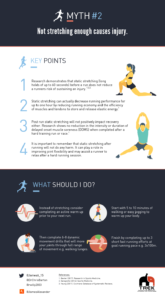It is a common belief amongst runners that static stretching (i.e. long holds of >15 seconds) decreases injury risk and improves running performance.1
Current research evidence demonstrates this belief is incorrect.1,2,3
Based on current research, stretching in the short or longer term has no impact on injury risk in runners.1 In fact static stretching prior to running may inhibit running performance for up to one hour.1 This is thought to be caused by a reduction in the mechanical efficiency of the lower body, primarily impacting the ability of the muscles and tendons to store and release elastic energy.3 Additionally, stretching has not been shown to reduce the intensity or the duration of DOMS following exhaustive exercise.1
It is important to point out that regular static stretching after running will not do any harm.
Stretching will improve joint flexibility but these improvements have not been associated with any benefits to recovery, performance or running economy in the long term.4
Runners should consider other strategies that will assist recovery after running. A progressive warm up including a gradual increase in intensity prior to completing harder running efforts or a race is recommended. Elite athletes in all running sports implement this practice.
A typical active warm up for a runner could progress like this:
- 5-10 minutes of walking or jogging.
- Complete 6-8 dynamic movement drills for a total of 5-10 minutes that will move your joints through full range of movement with particular focus on the lower limbs e.g. walking lunges, leg swings etc.
- Finish with 3-4 fast running efforts at goal running pace e.g. 3-4×100 meters.
To enhance recovery, ensuring you are getting enough sleep i.e. 7-9 hours or more each night, is the most important, cost effective and time efficient recovery method available for runners.5 Getting more sleep has proven beneficial effects on performance and recovery.5
References:
- Baxter, C., Mc Naughton, L. R., Sparks, A., Norton, L., & Bentley, D. (2017). Impact of stretching on the performance and injury risk of long-distance runners. Research in Sports Medicine, 25(1), 78-90.
- Saragiotto, B. T., Yamato, T. P., Junior, L. C. H., Rainbow, M. J., Davis, I. S., & Lopes, A. D. (2014). What are the main risk factors for running-related injuries?. Sports medicine, 44(8), 1153-1163.
- Yeung, S. S., Yeung, E. W., & Gillespie, L. D. (2011). Interventions for preventing lower limb soft-tissue running injuries. Cochrane Database of Systematic Reviews.
- Nelson, A. G., Kokkonen, J., Eldredge, C., Cornwell, A., & Glickman‐Weiss, E. (2001). Chronic stretching and running economy. Scandinavian journal of medicine & science in sports, 11(5), 260-265.
- Bonnar, D., Bartel, K., Kakoschke, N., & Lang, C. (2018). Sleep interventions designed to improve athletic performance and recovery: a systematic review of current approaches. Sports medicine, 48(3), 683-703.


